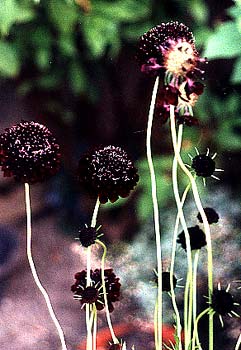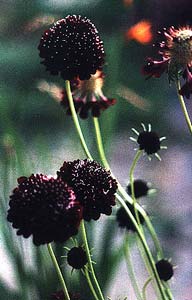
'Ace of Spades'
Pincushion Flower;
or Scabious
"In the sunlight against the green verges
Burning out under a skylark's ealtations
While the delicate scabious curtsied."
-Asphodel P. Long
b. 1921
b. 1921
This tender perennial or hardy annual will survive as a shortlived perennial where winters are mild. It self-seeds only moderately well. I loved it so much throughout its first year in our garden (2002) that I strongly hoped it would either grow back the following year or reseed itself for years to come.
There is no guarantee with this one, which can be a little saddening, as this flower is rather on the high end of amazing. We got lucky with it, perhaps because winter 2002 was so mild, perhaps because it is best categorized as a biennial with a tendency to persist for two years. It grew back for a second year as an even bigger clump, neck-high & full of buds by June 2003. By late spring 2004, however, it was obvious that it was not making a third-year comeback.
 Such good fortune increased my hope that it would survive perennially for some years to come, though that was apparently hoping for too much.
Such good fortune increased my hope that it would survive perennially for some years to come, though that was apparently hoping for too much.With a goodly amount of afternoon sun & good drainage in average soil without experiencing drought, it grows rapidly & produces a vast number of flowers throughout summer. Ours blooms continuously from June to August, then toward mid-September began blooming again, & had as many blossoms throughout October as it had at the height of summer.
The flowers are such a deep, dark, velvety maroon color that it is almost black (hence the cultivar name 'Ace of Spades'), displaying ball-shaped fully double pincushions. These are a very substantial blooms that look as though they have small white pins stuck into black velvet. The first year, the flower stems rose to shoulder height above two-foot tall mound of deeply cut leaves. The second year some of the flower stems slightly exceeded five feet.
The genus name is derived from "scabbies," an itching disease which pincushion flowers were once thought to cure. It has been used for centuries to treat skin conditions & was even believed to cure leprosy.
The flower's scent if very slight. It will rebloom with deadheading, though it's always a temptation to let the pincushion flowers go to seed on the fifty-fifty chance it will reseed itself. I let only a couple of the summer blossoms go to seed, & otherwise deadheaded it, with excellent result in achieving autumn rebloom. All the autumn flowers I let go to seed, but in three years there were never any self-sewn seedlings.
When the flowers lose their petals, each stem retains a large cone-like seedpod which is itself quite lovely. I save the stemmed cones for dry flower arrangments. These look pleasing in a vase full of the smaller & equally attractive Chocolate Cosmos seedheads. The marvelous fresh flowers are likewise suitable for bouquets.
Granny Artemis took to her office in Seattle a "black bouquet" of fresh cut Ace of Spades Scabiosa, Chocolate Cosmos, & deep dark leaves of Diablo Ninebark with lacecaps of blood-red seeds. She added a single bright red spike of Crocosmia to keep the bouquet from being overly gothic. The bouquet was quite the attention-grabber.
Scabiosa atropurea 'Qis Scarlet'
Scabiosa caucasica 'Perfecta Blue'
Scabiosa columbaria 'Pink Mist'